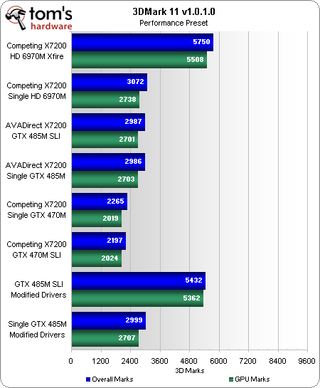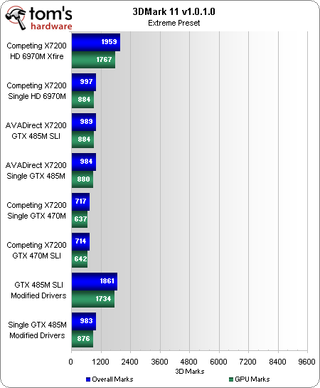AVADirect’s X7200: The GeForce GTX 485M SLI Mobile Graphics Giant
Hot on the heels of Eurocom’s Radeon HD 6970M CrossFire-based launch, AVADirect promises even bigger performance using pair of GeForce GTX 485M modules in SLI. Can AVADirect claim the performance crown at a lower price than its competition?
Benchmark Results: 3DMark
We put 3DMark at the end of today’s benchmark set because of its issues with SLI and, more specifically, our unsanctioned solution.
3DMark 11 didn’t support SLI from the outset, its publisher claiming issues with Nvidia’s drivers. Nvidia’s recent 266.66 desktop graphics driver adds SLI support to 3DMark 11, but doesn’t work with notebooks. Furthermore, the firm’s notebook driver development is typically several weeks behind its desktop software.
The easiest workaround we could think of would be to install desktop drivers on a notebook. Potential problems with that solution include possible overheating and crippled power management, but other than fried GPUs what’s the worst that could happen?

Because our “modified drivers” are unsanctioned and not used for the rest of today’s test, we placed the added results at the bottom of our charts. Comparing the single GeForce GTX 485M’s sanctioned (notebook driver version 265.77) and unsanctioned (desktop driver version 266.66) results, we see very little change. Yet, the unsanctioned drivers make a huge difference in SLI, where AVADirect’s configuration is roughly equal to its competitor’s CrossFire configuration.

Thus, we’ll treat the modified driver results as a preview of “fixed” 3DMark performance as we wait for an official release from Nvidia (as of March 24, 2011, there is a new driver posted to Nvidia's site, though there is no mention of SLI support for 3DMark in its release notes). At 3DMark’s Performance preset, the GeForce GTX 485M SLI setup with modified drivers falls only slightly behind the 6970M CrossFire solution.

Positioning remains consistent through 3DMark’s Extreme preset, with the 485M SLI a close match to the 6970M.
Though we haven’t seen any recent games with the SLI issue, ubiquity of 3DMark scores should have prompted Nvidia to shift into high-gear when it came to mobile driver development.
Stay on the Cutting Edge
Join the experts who read Tom's Hardware for the inside track on enthusiast PC tech news — and have for over 25 years. We'll send breaking news and in-depth reviews of CPUs, GPUs, AI, maker hardware and more straight to your inbox.
Current page: Benchmark Results: 3DMark
Prev Page Benchmark Results: S.T.A.L.K.E.R.: Call Of Pripyat Next Page Power Consumption And Battery Life-
tacoslave these thing are ridiculously expensive. Besides it seems dual gpu's(at least in the mobile sector) scale HORRIBLY in most scenerios.Reply -
LuckyDucky7 Those who really, really need the power, or just have lots of money to blow on stuff like this.Reply
Those who need to process large data sets on the go would likely see lots of use from a machine like this.
Also, those who develop software and need a mobile machine to showcase their new products (especially if that software happens to be a game).
Diminishing returns? Maybe with personal laptops < 1000 dollars. Not with this class of machine. -
Crashman tacoslavethese thing are ridiculously expensive. Besides it seems dual gpu's(at least in the mobile sector) scale HORRIBLY in most scenerios.If you look at the 1920x1080 highest detail results, it's somewhere around 60-80%. I wouldn't call that horrible. You do want to game at the panel's native resolution, no?Reply
-
Maziar Great review as always Crashman :)Reply
Judging from the specs,1 GTX 485M performance falls between a desktop GTX 460 and GTX 560Ti right ? -
Crashman MaziarGreat review as always Crashman Judging from the specs,1 GTX 485M performance falls between a desktop GTX 460 and GTX 560Ti right ?It looks that way on paper...I'm sure there's an X7200 review with a desktop card that you could use to make the conversions.Reply -
Maziar Yep,right.Reply
http://www.tomshardware.com/reviews/malibal-lotus-p150hm-geforce-gtx-485m-core-i7-2920xm,2855.html
But I liked to see a desktop system in the comparison charts. -
silverblue Crysis 1280x720 is a bit of an abberation for the 6970 in Crossfire. Had it not misbehaved there, the result would have been closer, however now AMD have to drop their prices as NVIDIA have brought out a very good solution.Reply -
americanbrian I kind of object to using all of the low resolution results on a configuration like this. It seems like all that it does is skew the results in favour of Nvidia, where in actual fact at the highest details and resolutions (i.e. the targeted area for a gaming laptop) the radeons conclusively win in performance.Reply
I understand that the value proposition is not very good still, but your conclusion is misleading in my opinion. People splashing out to be able to play the most modern games at highest res simply do not care how many excessive frames are pushed at the low end. -
Pointdexter Ok there's something I don't understand : on Eurocom's website an HD6970M costs 475$ LESS than an GTX 485M ... in fact the 6970M costs the same as an GTX 470MReply
so how can an SLI'd GTX 485 could be cheaper than an Xfire'd GTX 485M ?
Most Popular


